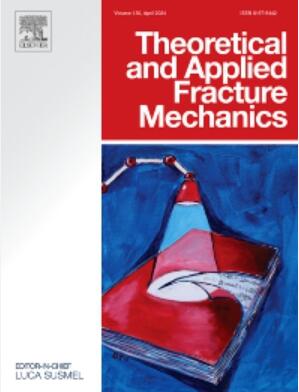Gpgpu-parallelized FDEM modelling of mode-I fracturing during the NSCB test under quasi-static and dynamic loading conditions
IF 5.6
2区 工程技术
Q1 ENGINEERING, MECHANICAL
引用次数: 0
Abstract
The hybrid finite-discrete element method (FDEM) demonstrates significant advantages in simulating the fracture and fragmentation of brittle materials. However, the traditional FDEM is computationally demanding and struggles to handle large-scale problems with numerous nodes, elements, and contact interactions. To enhance computational efficiency and scalability, the authors’ previously developed sequential hybrid FDEM open-source code has recently implemented its 2D/3D parallelization, using compute unified device architecture (CUDA) C/C++ based on the general-purpose graphic processing unit (GPGPU). The optimized code runs 128 times faster than its previous version. In this work, the GPGPU-parallelized hybrid FDEM is employed to simulate the notched semi-circular bend (NSCB) tests under quasi-static and dynamic loading. The simulation results accurately capture the deformation trends, fracture patterns, and post-failure characteristics observed in laboratory experiments. The influence of loading rate on rock fracture behavior, force–displacement curve, and fracture toughness was discussed. It is revealed that the essential difference between static and dynamic behavior lies in the interaction of dynamic effects with the material’s structural effects during dynamic loading. Specifically, with increasing loading rate, the notch effect in the NSCB specimen diminishes until complete elimination, and the failure mode transitions from a single splitting failure to a mixed shear-tension failure. Furthermore, a critical loading rate threshold is identified, after which the fracture toughness of the specimen increases linearly while remaining essentially constant before reaching it. This study demonstrates that the GPGPU-parallelized hybrid FDEM is a robust and effective numerical tool for investigating the continuous-discontinuous deformation of brittle materials in rock engineering applications.
准静态和动态加载条件下NSCB试验ⅰ型压裂的gpgpu并行FDEM建模
混合有限-离散元法(FDEM)在模拟脆性材料的断裂和破碎方面具有显著的优势。然而,传统的FDEM计算量大,难以处理具有众多节点、元素和接触交互的大规模问题。为了提高计算效率和可扩展性,作者之前开发的顺序混合FDEM开源代码最近实现了其2D/3D并行化,使用基于通用图形处理单元(GPGPU)的计算统一设备架构(CUDA) C/ c++。优化后的代码运行速度比之前的版本快128倍。本文采用gpgpu -并行化混合FDEM模拟了准静态和动态载荷作用下的缺口半圆弯曲试验。模拟结果准确地捕捉了实验室实验中观察到的变形趋势、断裂模式和破坏后特征。讨论了加载速率对岩石断裂行为、力-位移曲线和断裂韧性的影响。结果表明,在动力加载过程中,动力效应与材料结构效应的相互作用是材料静力与动力性能的本质区别。随着加载速率的增加,NSCB试样的缺口效应逐渐减弱,直至完全消除,破坏模式由单一劈裂破坏转变为剪切-拉伸混合破坏。此外,还确定了一个临界加载率阈值,在此阈值之后,试样的断裂韧性呈线性增加,但在达到该阈值之前基本保持不变。研究表明,gpgpu -并行化混合FDEM是研究岩石工程中脆性材料连续-不连续变形的一种鲁棒、有效的数值工具。
本文章由计算机程序翻译,如有差异,请以英文原文为准。
求助全文
约1分钟内获得全文
求助全文
来源期刊

Theoretical and Applied Fracture Mechanics
工程技术-工程:机械
CiteScore
8.40
自引率
18.90%
发文量
435
审稿时长
37 days
期刊介绍:
Theoretical and Applied Fracture Mechanics'' aims & scopes have been re-designed to cover both the theoretical, applied, and numerical aspects associated with those cracking related phenomena taking place, at a micro-, meso-, and macroscopic level, in materials/components/structures of any kind.
The journal aims to cover the cracking/mechanical behaviour of materials/components/structures in those situations involving both time-independent and time-dependent system of external forces/moments (such as, for instance, quasi-static, impulsive, impact, blasting, creep, contact, and fatigue loading). Since, under the above circumstances, the mechanical behaviour of cracked materials/components/structures is also affected by the environmental conditions, the journal would consider also those theoretical/experimental research works investigating the effect of external variables such as, for instance, the effect of corrosive environments as well as of high/low-temperature.
 求助内容:
求助内容: 应助结果提醒方式:
应助结果提醒方式:


